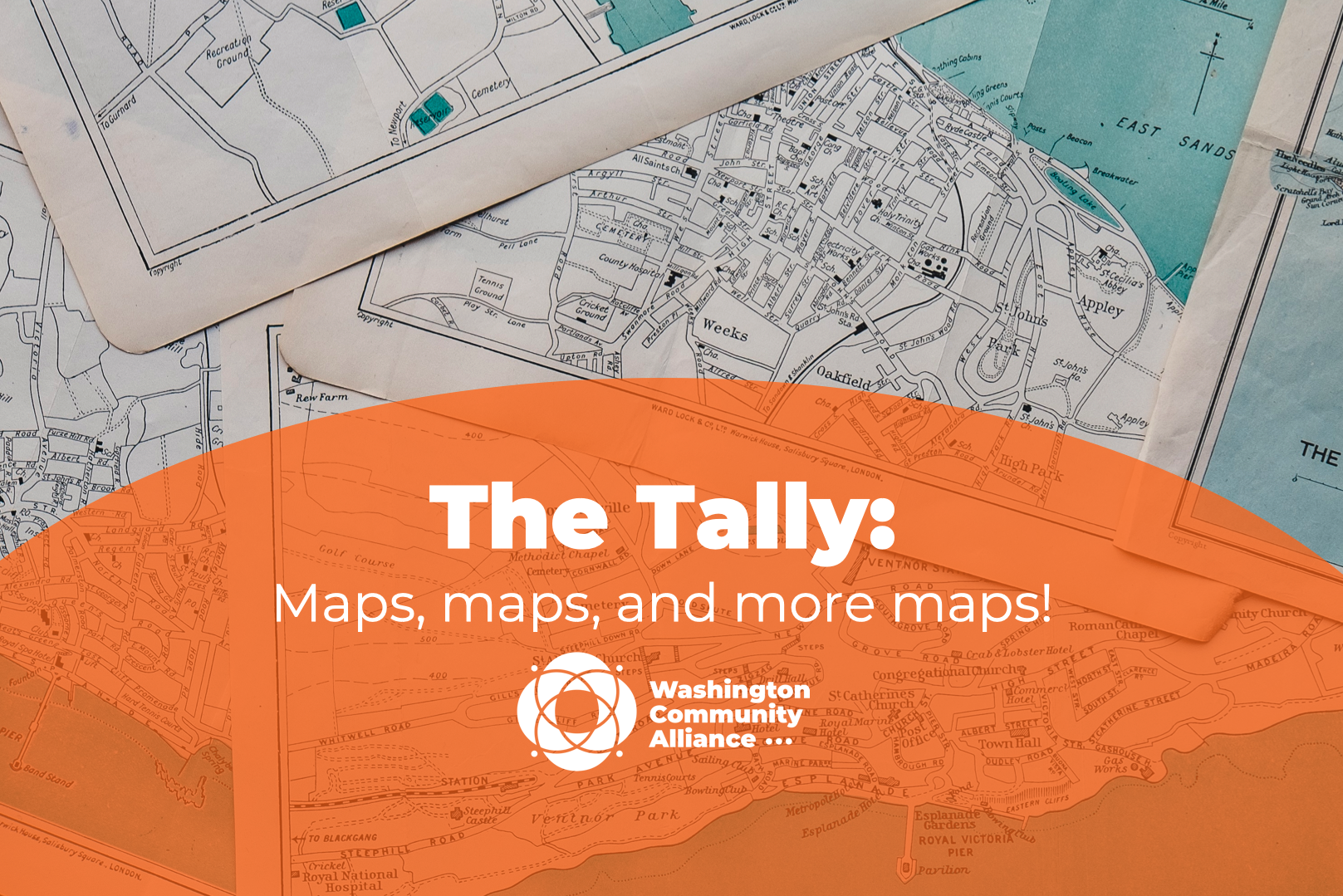
We’re in the thick of redistricting. 4 commissioners—2 Democrats and 2 Republicans—are duking it out, proposing different versions of Legislative and Congressional maps that, by state law, must be:
- Equal (have about the same number of people in each district)
- Compact (the shapes can’t get too wacky)
- Contiguous (has to be connected)
- Competitive (can’t lean too heavily Democrat or Republican)
- Preserve political subdivisions (follows the lines of counties, cities, school districts, etc.)
- Preserve communities of interest (demographic communities, neighborhoods, tribes, etc. should not be split)
After our 7 Big Takeaways below, we take a deeper dive into what we’re seeing in Yakima, Snohomish and South King Counties. And before we get too ahead of ourselves, know that you’re gonna see the acronym CVAP, or Citizen Voting Age Population, thrown around a lot. Basically, CVAP means the population of eligible voters in the district. CVAP is a very important metric when it comes to redistricting because districts with a large population of people of color may not necessarily mean that it has a lot of voters of color. So as self-serving commissioners like Paul Graves show us, you can draw “historic” majority-minority districts (by including kids of color) while literally disenfranchising the Black and brown communities you applaud yourself for empowering. We wish we were making that last part up.
7 Big Takeaways
- Latino community in Yakima can sue the state if the Republicans get their way. Right now only the Democrats have proposed maps of the 14th and 15th Legislative Districts that maintain a Latino CVAP majority, which the Washington Voting Rights Act (WVRA) requires.
- The Yakama Nation gains strength. Finally, the Yakama Nation will be able to exercise its political will as a cohesive unit. Previously gerrymandered maps had split the reservation, but every commissioner rectified that in their proposals.
- Only Democrats care about Black and Brown representation in South King County. Though Democratic commissioners have proposed BIPOC CVAP majorities in LDs 11, 33, 37 and overall BIPOC majorities in 30 and 47, all have left out Auburn and the Muckleshoot Nation from majority BIPOC districts, diluting their political power.
- No commissioners created a majority Black and brown 21st LD in Snohomish county. That’s a mistake.
- Creepy Joe Fain wants his seat back and is leading the Republican partisan gerrymandering of his home district, the 47th LD. It marginalized those communities, and communities in both Bainbridge Island and the Seattle-area 36th and 43rd LDs that were gerrymandered together to make room for a majority-white 47th district.
- Redistricting has its limits. While people of color comprise nearly 40% of the state, in 0 Congressional Districts do we make up a majority of voters. On the legislative map, we have just 1 of 49 districts. We should be able to elect over a third of our legislators and representatives, but that won’t happen without reforming our “winner-take-all” system which was designed to ensure the minority didn’t have equitable political power (watch this to learn more).
- The fight’s not over. Sign up to testify at one of the final public hearings in early October (we’ll help you prep!!) And sign on to endorse our map proposals!
Deep Dive – Congressional Districts
In King County districts, commissioners had a clear intention to preserve incumbents. Despite the League of Women Voters and Redistricting Justice for Washington both proposing a 9th district with diverse South Seattle and without Bellevue, three proposals exclude parts of South Seattle; while all four proposals include Bellevue, home to Congressman Adam Smith. With respect to the 1st district, Democrats also snaked in Medina, where Congresswoman Suzan DelBene lives.
9th CD:
- Brady (D) – GOOD:
- Burien joins southeast Seattle and South King County
- Keeps together majority cities of color, Kent, Auburn (King County), Des Moines, Newcastle, Tukwila, Renton, Federal Way and Bellevue (south of I-90)
- Graves (R) – DIVIDES CVAP MAJORITIES: Create 2 majority minority by population districts by sacrificing having any majority minority districts in WA
- Sims (D) and Fain (R) – NOT GOOD: Both combine South Seattle with the North end
In South King and North Pierce Counties, the 9th is currently Washington’s only majority-minority CD. All proposed maps maintain this status—however, Republican Commissioner Graves splits voters of color across the 9th and 10th. Graves brags about establishing two majority-minority population districts, however, his plan reduces the number voters of color in both districts, weakening our communities’ political power. That’s how you know he’s a lawyer and a professional politician.
Deep Dive – Legislative Districts
Yakima
- All commissioners kept the Yakama Nation intact
- Democrats and Republicans divided on whether to make majority-minority CVAP district with Yakima Latino voters or split them between 14th & 15th
- Republicans likely violate Voting Rights Act requirements
In Yakima County, commissioners listened to community and redrew the 14th and 15th legislative districts to improve Latino and Native representation. All four commissioners drew maps that brought together the previously split Yakama Reservation. However, Democrats drew a substantial majority-Latino CVAP district, while Republican commissioners drew only majority-white CVAP districts.
What this means is the maps from Republican Commissioners almost certainly violate Section 2 of the Federal Voting Rights Act. If either are approved, Latino voters could sue to create a majority Latino district in South Yakima County. Given Latino population growth in recent years, racial polarization in voting, and the highly segregated nature of Yakima County, experts suggest a Latino opportunity district must be measured by CVAP and should include the Yakama Nation in a minority coalition. As David Morales, attorney and local community advocate, put it, “Rather than submitting this plan for future lawsuits it would be beneficial to everyone and save a lot of time and money if the ultimate plan adhered to both the Voting Rights Act and the Federal Voting Rights Act.”
South King County
- 37th – GOOD – But creepy Joe Fain is trying to gerrymander Chinatown
- 11th – GOOD
- 33rd – WE’LL TAKE IT!
- 30th – WE’LL TAKE IT!
- 47th – NEEDS WORK – This should be a majority BIPOC district that includes Auburn and the Muckleshoot Nation
All commissioners opted for similar 11th and 37th districts with the exception of Fain, who drew Seattle’s Chinatown-International District outside the 37th district and parts of Newcastle and Bellevue into the Renton-Tukwila-based 11th district. The biggest difference was in the 47th district. Democrats drew maps that prioritized majority-minority representation in this rapidly diversifying region. Republicans carved the 47th district further east, fracturing any possible majority-minority district in South King County. To do this, they excluded a diverse Auburn and the Muckleshoot Nation while combining Seattle-area districts 43 and 36 with Bainbridge Island, splitting county boundaries in odd ways.
Snohomish
- 21st LD – BAD – All commissioners failed to make this a majority Black and brown district
2020 census data showed growing diversity in Snohomish, prompting community members to advocate for the first-ever majority-minority district in the county with the 21st district. While no commissioner fulfilled that promise we’ll be lobbying for a majority-minority district in the upcoming public outreach meeting on October 5. It’s disappointing to see that every commissioner opted to keep in line with current district boundaries, which awkwardly connect working-class communities of color along the I-5 corridor with white, wealthy waterfront communities like Mukilteo and Edmonds. It’s even more disappointing to realize both Sen. Marko Liias and Rep. Strom Peterson live in those wealthy, white enclaves, which dilute the voting power of communities of color and the working-class. In this case, it seems both Democratic commissioners prioritized protecting the incumbents over empowering voters of color
And that’s the deep dive! It’s clear that our community voices are being heard loud and clear—but we’ve still got work to do to make sure these maps represent us. You can still get involved: sign up to testify with us at one of the final public hearings in early October (we’ll help you prep!!) And sign on to endorse our map proposals!
What do you think? Have any questions? Tweet us your thoughts @wacommalliance. Keep up with the action and opportunities to get involved with our legislative newsletter The Tally.

